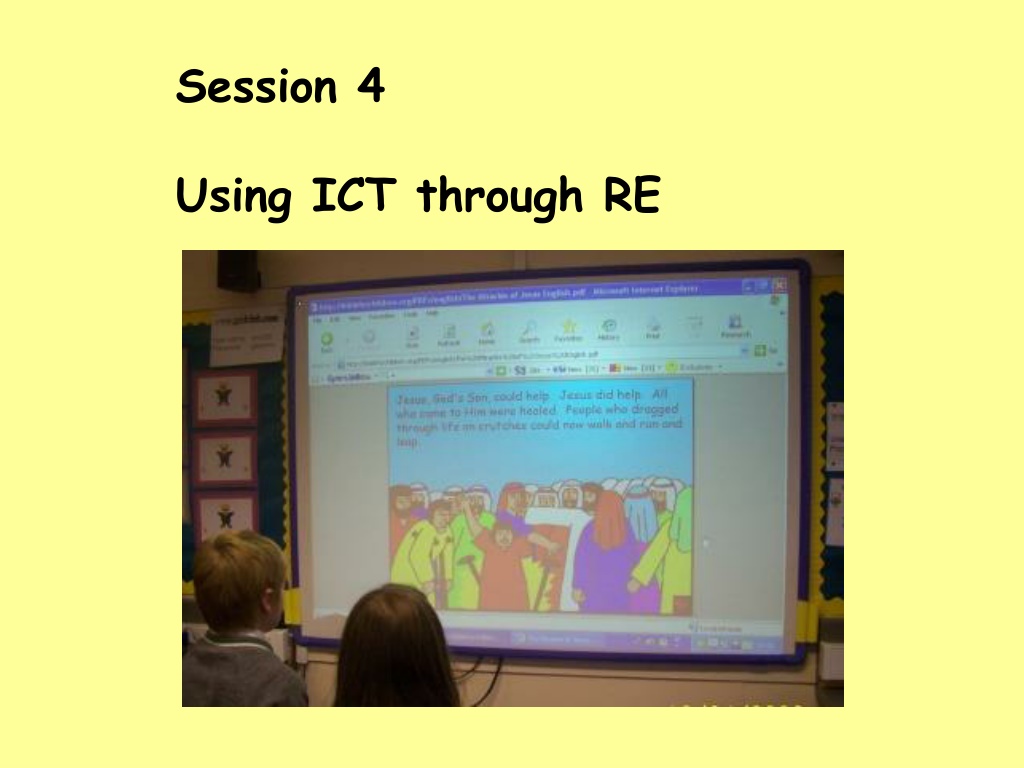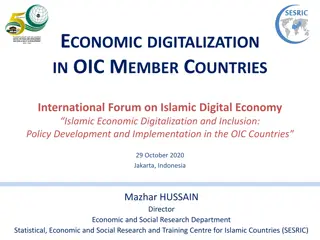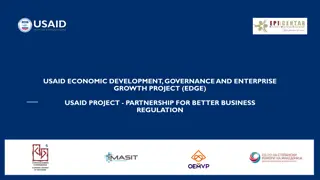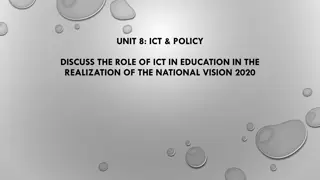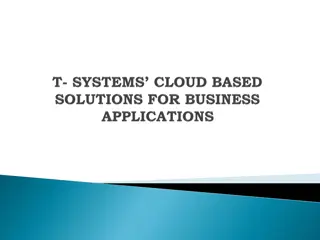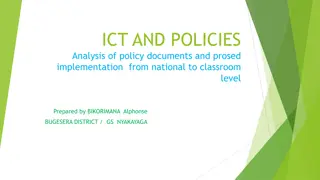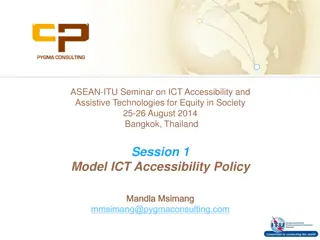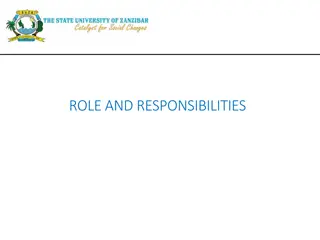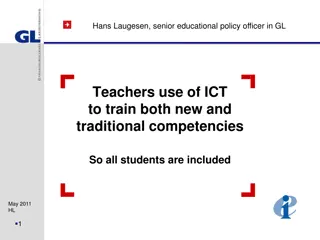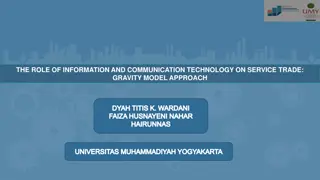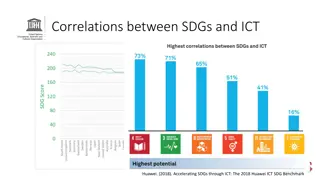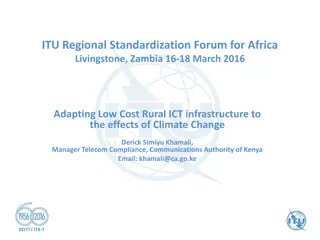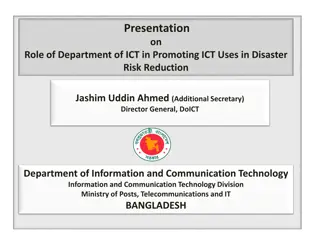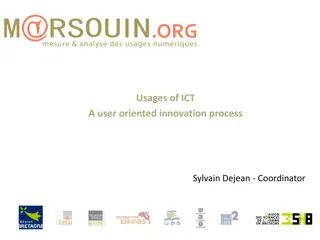Session 4: ICT Integration for Better Learning
Enhance your teaching with effective ICT strategies. Discover how to integrate technology to engage students and improve learning outcomes. Explore practical tips and ideas for utilizing ICT tools in the classroom. Gain insights on maximizing the Benefits of ICT in education and creating dynamic learning experiences for your students. Elevate your teaching practices with innovative and interactive ICT solutions. Join us in this session to empower your teaching with the latest technology resources.
Download Presentation

Please find below an Image/Link to download the presentation.
The content on the website is provided AS IS for your information and personal use only. It may not be sold, licensed, or shared on other websites without obtaining consent from the author.If you encounter any issues during the download, it is possible that the publisher has removed the file from their server.
You are allowed to download the files provided on this website for personal or commercial use, subject to the condition that they are used lawfully. All files are the property of their respective owners.
The content on the website is provided AS IS for your information and personal use only. It may not be sold, licensed, or shared on other websites without obtaining consent from the author.
E N D
Presentation Transcript
Session 4 Using ICT through RE
Objectives To present examples of pedagogy in classroom practice; To consider and investigate the use of ICT in the RE classroom to engage and challenge pupils; To reflect on and evaluate the usefulness of a variety of ICT resources To understand more about the world religions
There are six pedagogical principles that really underpin the teaching of RE: 1. Remember the child: 2. Start with the particular and help children see connections: 3.Look for similarities between the children s experiences and the specific religious experience: 4. Also acknowledge difference: 5. Draw out the themes for AT2 Learning from Religion: 6. Seek to engage head, heart and hand: McCreery, E., Palmer, S. & Voiels, V. (2008) Achieving QTS: Teaching Religious Education Exeter: Learning Matters pg 18-24 For session 4 , in groups, decide on the main elements of your allocated principle and present the group with a brief activity/experience that puts that principle into practice. This needs to be in a electronic format that can then be included in your blogfolio.
The key document which is essential reading is: Primary RE with ICT: A pupil s entitlement to ICT in primary RE (2009) http://www.bee- it.co.uk/Guidance%20Docs/Becta%20Files/Schools/Curriculum/Religious%20Education/02%20ICT%20in%20pri mary%20religious%20educationm%20A%20pupil's%20entitlement.pdf As technology becomes a greater part of everyday life, it is only natural that it becomes a central and essential part of 21st century learning. Learners are already engaging extensively with technology and expect it to be used in school. [Becta : The 21st century teacher: religious education Using technology to enhance religious education teaching]
Effective use of ICT in RE can: allow pupils to investigate or be creative in ways not possible otherwise facilitate safe communication with peers and other communities, locally, nationally and globally provide access to authentic information, insights and resources from the world s religious communities bringing the world of religion into the classroom engage pupils in the selection, critical use and interpretation of a wide range of information help pupils to understand important, and complex, ideas support pupils in organising, recording, reporting and communicating findings enable pupils to see patterns or behaviours more clearly enhance the quality of presentations. [Primary RE with ICT: A pupil s entitlement to ICT in primary RE]
ICT can be used in RE to: 1. Enhance teaching and learning by: using a range of technologies to cater for different learning styles using technology to enable learners to collaborate with peers and with partner schools and their students. 2. Improve administration and planning: for learning and teaching, reusing and adapting documents by using technology to access and share information and enhance your personal knowledge of RE and understanding of professional issues around the subject.
3. Improve assessment and reporting by: recording learner achievement and attainment electronically, tracking pupil progress and using the information in assessment for learning communicating with parents electronically through email and the school learning platform. Etc. [Primary RE with ICT: A pupil s entitlement to ICT in primary RE]
Why use ICT? Wider Creative communication allow pupils to investigate or be creative in ways not possible otherwise facilitate safe communication with peers and other communities, locally, nationally and globally provide access to authentic information, insights and resources from the world s religious communities bringing the world of religion into the classroom engage pupils in the selection, critical use and interpretation of a wide range of information help pupils to understand important, and complex ideas Critical resource selection Bringing sources to life Presentation support pupils in organising, recording, reporting and communicating findings enable pupils to see patterns or behaviours more clearly enhance the quality of presentations [BECTA 2009]
Bias INCORRECT INFORMATION What problems can you see with using the internet for investigation into RE with primary children? Information too complicated Radicalisation
We MUST consider: WOULD THE RE LEARNING OUTCOMES BE ACHIEVED AS OR MORE EFFECTIVELY WITHOUT THE USE OF ICT? When planning to use ICT in RE lessons, whether the ICT is adding value to the lesson/activity. Internet safety
The Largest main World Religions in order are: Christianity: 2.1 billion. Islam: 1.3 billion. Hinduism: 900 million. Buddhism: 376 million. Sikhism: 23 million. Judaism: 14 million.
Atheism Atheists are people who believe that god or gods are man-made constructs. Baha'i One of the youngest of the world's major religions. Buddhism A way of living based on the teachings of Siddhartha Gautama. Candombl A religion based on African beliefs, originating in Brazil. Christianity The world's biggest faith, based on the teaching of Jesus Christ. Hinduism A group of faiths rooted in the religious ideas of India. Islam Revealed in its final form by the Prophet Muhammad. Jainism An ancient philosophy and ethical teaching that originated in India. Jehovah's Witnesses A Christian-based evangelistic religious movement
Judaism Based around the Jewish people's covenant relationship with God. Mormonism The Church of Jesus Christ of Latter-day Saints. Paganism Contemporary religions usually based on reverence for nature. Rastafari A young religion founded in Jamaica in the 1930s. Santeria Afro-Caribbean syncretic religion originating in Cuba. Shinto Japanese folk tradition and ritual with no founder or single sacred scripture. Sikhism The religion founded by Guru Nanak in India in the 15th Century CE. Spiritualism Spiritualists believe in communication with the spirits of people who have died. Taoism An ancient tradition of philosophy and belief rooted in Chinese worldview. Unitarianism An open-minded and individualistic approach to religion. Zoroastrianism One of the oldest monotheistic faiths, founded by the Prophet
Christianity at a glance Christianity is the most popular religion in the world with over 2 billion adherents. 42 million Britons see themselves as nominally Christian, and there are 6 million who are actively practising. Christians believe that Jesus was the Messiah promised in theOld Testament. Christians believe that Jesus Christ is the Son of God. Christians believe that God sent his Son to earth to save humanity from the consequences of its sins. One of the most important concepts in Christianity is that of Jesus giving his life on the Cross (the Crucifixion) and rising from the dead on the third day (the Resurrection). Christians believe that there is only one God, but that there are three elements to this one God: God the Father God the Son The Holy Spirit Christians worship in churches. Their spiritual leaders are called priests or ministers. The Christian holy book is the Bible, and consists of the Old and New Testaments. Christian holy days such as Easter and Christmas are important milestones in the Western secular calendar
Islam at a glance The word Islam means 'submission to the will of God'. Islam is the second largest religion in the world with over 1 billion followers. The 2001 census recorded 1,591,000 Muslims in the UK, around 2.7% of the population. Muslims believe that Islam was revealed over 1400 years ago in Mecca, Arabia. Followers of Islam are called Muslims. Muslims believe that there is only One God. The Arabic word for God is Allah. According to Muslims, God sent a number of prophets to mankind to teach them how to live according to His law. Jesus, Moses and Abraham are respected as prophets of God. They believe that the final Prophet was Muhammad. Muslims believe that Islam has always existed, but for practical purposes, date their religion from the time of the migration of Muhammad. Muslims base their laws on their holy book the Qur'an, and the Sunnah. Muslims believe the Sunnah is the practical example of Prophet Muhammad and that there are five basic Pillars of Islam. These pillars are the declaration of faith, praying five times a day, giving money to charity, fasting and a pilgrimage to Mecca (atleast once).
Introduction to Hinduism Hinduism is the religion of the majority of people in India and Nepal. It also exists among significant populations outside of the sub continent and has over 900 million adherents worldwide. In some ways Hinduism is the oldest living religion in the world, or at least elements within it stretch back many thousands of years. Yet Hinduism resists easy definition partly because of the vast array of practices and beliefs found within it. It is also closely associated conceptually and historically with the other Indian religions Jainism, Buddhismand Sikhism. Unlike most other religions, Hinduism has no single founder, no single scripture, and no commonly agreed set of teachings. Throughout its extensive history, there have been many key figures teaching different philosophies and writing numerous holy books. For these reasons, writers often refer to Hinduism as 'a way of life' or 'a family of religions' rather than a single religion.
Although it is not easy to define Hinduism, we can say that it is rooted in India, most Hindus revere a body of texts as sacred scripture known as the Veda, and most Hindus draw on a common system of values known as dharma. Hinduism originated around the Indus Valley near the River Indus in modern day Pakistan. About 80% of the Indian population regard themselves as Hindu. Most Hindus believe in a Supreme God, whose qualities and forms are represented by the multitude of deities which emanate from him. Hindus believe that existence is a cycle of birth, death, and rebirth, governed by Karma. Hindus believe that the soul passes through a cycle of successive lives and its next incarnation is always dependent on how the previous life was lived. The main Hindu texts are the Vedas and their supplements (books based on the Vedas). Veda is a Sanskrit word meaning 'knowledge'. These scriptures do not mention the word 'Hindu' but many scriptures discuss dharma, which can be rendered as 'code of conduct', 'law', or 'duty' Hindus celebrate many holy days, but the Festival of Lights,Diwali is the best known. The 2001 census recorded 559,000 Hindus in Britain, around 1% of the population.
Buddhism is a spiritual tradition that focuses on personal spiritual development and the attainment of a deep insight into the true nature of life. There are 376 million followers worldwide. Buddhists seek to reach a state of nirvana, following the path of the Buddha, Siddhartha Gautama, who went on a quest for Enlightenment around the sixth century BC. There is no belief in a personal god. Buddhists believe that nothing is fixed or permanent and that change is always possible. The path to Enlightenment is through the practice and development of morality, meditation and wisdom. Buddhists believe that life is both endless and subject to impermanence, suffering and uncertainty. These states are called the tilakhana, or the three signs of existence. Existence is endless because individuals are reincarnated over and over again, experiencing suffering throughout many lives. It is impermanent because no state, good or bad, lasts forever. Our mistaken belief that things can last is a chief cause of suffering. The history of Buddhism is the story of one man's spiritual journey to enlightenment, and of the teachings and ways of living that developed from it.
The Buddha Siddhartha Gautama, the Buddha, was born into a royal family in present-day Nepal over 2500 years ago. He lived a life of privilege and luxury until one day he left the royal enclosure and encountered for the first time, an old man, a sick man, and a corpse. Disturbed by this he became a monk before adopting the harsh poverty of Indian asceticism. Neither path satisfied him and he decided to pursue the Middle Way - a life without luxury but also without poverty. Buddhists believe that one day, seated beneath the Bodhi tree (the tree of awakening), Siddhartha became deeply absorbed in meditation and reflected on his experience of life until he became enlightened. By finding the path to enlightenment, Siddhartha was led from the pain of suffering and rebirth towards the path of enlightenment and became known as the Buddha or 'awakened one'.
Key facts Buddhism is 2,500 years old There are currently 376 million followers worldwide There are over 150,000 Buddhists in Britain Buddhism arose as a result of Siddhartha Gautama's quest for Enlightenment in around the 6th Century BC There is no belief in a personal God. It is not centred on the relationship between humanity and God Buddhists believe that nothing is fixed or permanent - change is always possible The two main Buddhist sects are Theravada Buddhism andMahayana Buddhism, but there are many more Buddhists can worship both at home or at a temple The path to Enlightenment is through the practice and development of morality, meditation and wisdom.
Judaism is the original of the three Abrahamic faiths, which also includes Christianity andIslam. According to information published by The Jewish People Policy Planning Institute, there were around 13.1 million Jewish people in the world in 2007, most residing in the USA and Israel. According to the 2001 census 267,000 people in the UK said that their religious identity was Jewish, about 0.5% of the population. Judaism originated in the Middle East over 3500 years ago Judaism was founded by Moses, although Jews trace their history back to Abraham. Jews believe that there is only one God with whom they have a covenant. In exchange for all the good that God has done for the Jewish people, Jewish people keep God s laws and try to bring holiness into every aspect of their lives. Judaism has a rich history of religious text, but the central and most important religious document is the Torah. Jewish traditional or oral law, the interpretation of the laws of the Torah, is called halakhah. Spiritual leaders are called Rabbis. Jews worship in Synagogues. 6 million Jews were murdered in the Holocaust in an attempt to wipe out Judaism. There are many people who identify themselves as Jewish without necessarily believing in, or observing, any Jewish law.
Sikhism at a glance There are 20 million Sikhs in the world, most of whom live in the Punjab province of India. The 2001 census recorded 336,000 Sikhs in the UK. Sikhism was founded in the 16th century in the Punjab district of what is now India and Pakistan. It was founded by Guru Nanak and is based on his teachings, and those of the 9 Sikh gurus who followed him. The most important thing in Sikhism is the internal religious state of the individual. Sikhism is a monotheistic religion Sikhism stresses the importance of doing good actions rather than merely carrying out rituals Sikhs believe that the way to lead a good life is to: keep God in heart and mind at all times live honestly and work hard treat everyone equally be generous to the less fortunate serve others The Sikh place of worship is called a Gurdwara The Sikh scripture is the Guru Granth Sahib, a book that Sikhs consider a living Guru The tenth Sikh Guru decreed that after his death the spiritual guide of the Sikhs would be the teachings contained in that book, so the Guru Granth Sahib now has the status of a Guru, and Sikhs show it the respect they would give to a human Guru. The community of men and women who have been initiated into the Sikh faith is the Khalsa. The Khalsa celebrated its 300th anniversary in 1999. Guru Gobind Singh decreed that where Sikhs could not find answers in the Guru Granth Sahib, they should decide issues
Task In groups of no more than 4 you are going to do the following; 1. Look through the list of the different apps and decide which will be useful and which will not and have a brief explore of them. 2. Design a resource using ICT that can be used to teach an aspect of one of the world religions to a KS1 class.(remember differentiation) 3. Plan a lesson for a KS2 class using different ICT applications. Remember the pedagogical principles! There are six pedagogical principles that really underpin the teaching of RE: 1. Remember the child: 2. Start with the particular and help children see connections: 3.Look for similarities between the children s experiences and the specific religious experience: 4. Also acknowledge difference: 5. Draw out the themes for AT2 Learning from Religion: 6. Seek to engage head, heart and hand:
Religious Education has the creative advantage of freedom from the paraphernalia of assessment as prescribed for other subjects, i.e. nationally imposed learning goals, level descriptions, National Curriculum and Foundation Stage Assessments. However, this can be construed as hindering the credibility of the subject with parents and pupils.
Is Religious Education hindered, or at an advantage, as an academic subject because it is not regulated in the same way as other curriculum subjects?
Assessing- how and why? Think, pair, share all the ways of assessing there could be in an RE lesson Talk, listening, explaining, Q&As, reflection on/evaluation of documents/artefacts, drawing, writing, sequencing, group work jigsaw/expert groups, role play, hot seating, phrasing own questions for a visitor/expert, feeding back on research etc.
Making a judgement At the end of a key stage, teachers should judge which level description best fits the pupil's performance. Each description should be considered alongside descriptions for adjacent levels. When making a judgement at the end of a key stage, you may wish to note the following points. Making your judgement You will arrive at judgements by taking into account strengths and weaknesses in performance across a range of contexts and over a period of time, rather than focusing on a single piece of work. A single piece of work will not cover all the expectations set out in a level description. It will probably provide partial evidence of attainment in one or two aspects of a level description. If you look at it alongside other pieces of work covering a range of contexts you will be able to make a judgement about which level best fits a pupil's overall performance.
Giving pupils opportunities to demonstrate attainment Your pupils will need to use a range of forms of communication to show what they can do. In planning units of work and classroom approaches, you will need to provide opportunities for pupils to display their achievements in different ways, and to work in a range of situations. The attainment target aspects are intended to help in planning teaching and learning by providing a focus for appropriate task setting
Can do RE statements AT1 Learning about Religion Can you devise some Can do statements for RE? AT2 Learning From Religion
What is 'Assessment for Learning (AfL)? Assessment FOR learning involves: 'gathering and interpreting evidence about pupils' learning'; and 'learners and their teachers using that evidence to decide where pupils are in their learning, where they are going and how to take the next steps'. (QCA and the Assessment Reform Group, 2001) An important part of assessment for learning is pupils' self-assessment. As Black & Wiliam say: 'Pupils should be trained in self-assessment so that they can understand the main purposes of their learning and thereby grasp what they need to do to achieve'. (Inside the Black Box (1998), Kings College, London)
QCA has identified the following key features of assessment for learning: embedded in the teaching and learning process of which it is an essential part sharing learning goals with pupils helping pupils to know and to recognise the standards to aim for providing feedback which leads pupils to identify what they should do next to improve having a commitment that every pupil can improve involving both teacher and pupils in reviewing and reflecting on pupils' performance and progress involving pupils in self-assessment. To improve the quality of assessment for learning, QCA suggests: 1. Involving pupils in their learning 2. Modelling quality: showing pupils the learning strategies and goals 3. Giving feedback to pupils on their work 4. Self assessment and peer assessment.
For further examples see: http://www.reo nline.org.uk/ass essing/how/leve l-examples/ ASSESSING PUPILS WORK Task: 1. Read the examples of pupils work 2. In your groups use the Attainment targets and Levels sheet to create a comment about each piece and agree a level for it. Handouts 3 & 4 Handout 5 suggested levels
Directed Tasks Select 2 or more of a choice of websites on the internet for review in the context of teaching and learning in Religious Education and present reviews to peers through the Blogfolio. What are the benefits and constraints of using ICT? Add views to Blogfolio. Go to the school experience section in the library and choose a resource to share with the rest of the group in the next session. You will need to justify your resource. Reflect upon your taught session and directed tasks and develop your Blogfolio, uploading completed tasks.
Essential Reading McCreery, E., Palmer, S. & Voiels, V. (2008) Achieving QTS: Teaching Religious Education Exeter: Learning Matters Ch. 4, 5, 7, 8. Allen, J., Potter, J., Sharp, J. & Turvey. (2012) Primary ICT Knowledge, Understanding and Practice (5th Ed). London. Sage/Learning Matters Pages 8 and 9 and page 56. Primary RE with ICT: A pupil s entitlement to ICT in primary RE (2009) http://www.beeit.co.uk/Guidance%20Docs/Becta%20Files/School s/Curriculum/Religious%20Education/02%20ICT%20in%20primar y%20religious%20educationm%20A%20pupil's%20entitlement.pdf
